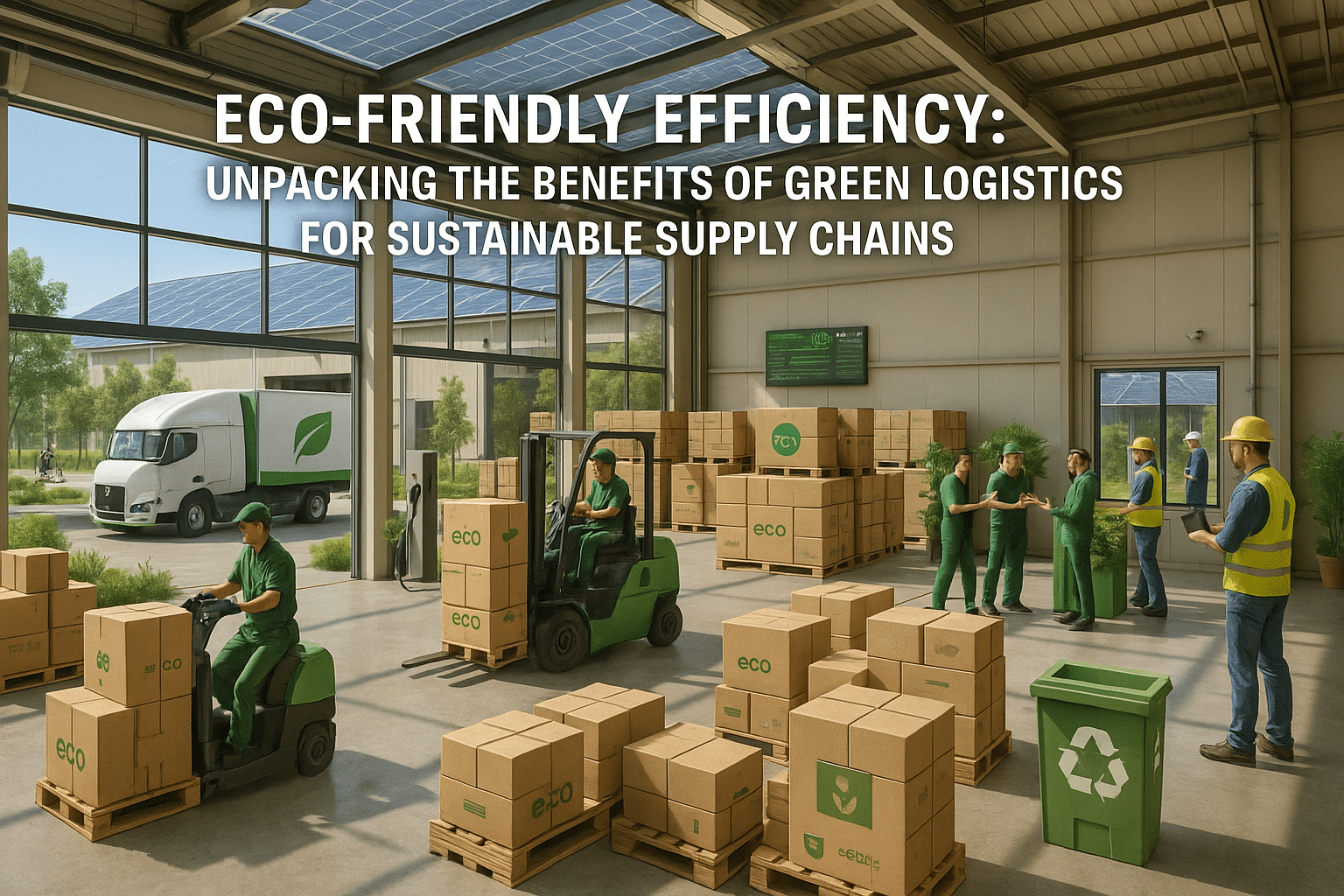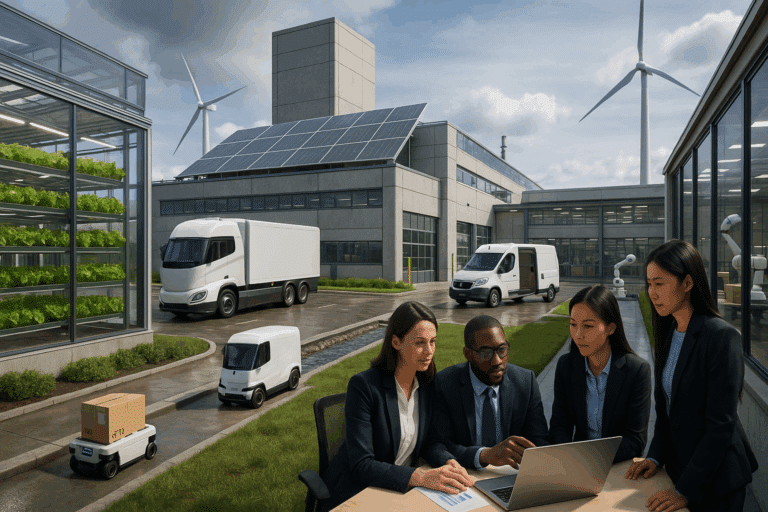🌿 Balancing the ecological footprint with economic efficiency is not just a lofty ideal but an imperative strategy for sustainable growth in today’s world. This article will serve as your comprehensive guide to understanding, and implementing green logistics to create a more sustainable supply chain.
Now, you might be wondering, what exactly are green logistics? How do they add value to my existing supply chain setup? And, more importantly, what are the practical steps that I can take to integrate them into my business operations? Well, keep your seatbelts fastened, as we’re about to embark on a journey to explore the fascinating and complex world of eco-friendly efficiency. 😊
At a fundamental level, green logistics refers to an array of strategies focused on reducing the environmental impact of supply chain operations. This includes everything from eco-friendly packaging and optimized transportation routes to the use of renewable energy sources and end-of-life product management. But there’s much more to it than that! In the forthcoming sections, we will delve deeper into the essential aspects of green logistics, providing a clearer understanding of its multifaceted nature.
But why is this shift towards green logistics a pertinent topic today? We live in a world where consumers are more conscious and informed than ever before about the environmental impacts of their purchases. This consciousness extends beyond the product itself, to its entire lifecycle. From the sourcing of raw materials to the disposal of the product after use, every stage is under scrutiny. As such, businesses that fail to adapt to this green paradigm may find themselves losing market share.
However, it’s not all about staying in line with consumer expectations. Implementing green logistics can also offer significant advantages for your business. From cost savings and increased efficiency to improved brand reputation and competitive advantage, the benefits are manifold.💡In the sections to follow, we will unpack these benefits in detail, helping you to understand why green logistics are an investment worth making.
We also recognize that making such a transition can be daunting. Therefore, we will also provide a roadmap for implementing green logistics. We’ll delve into the practical steps that can be taken, from initial assessment and planning through to execution and evaluation.
This journey promises to be as enlightening as it is exciting. We invite you to join us as we unravel the many layers of green logistics. With every line, every section, and every insight, we hope to spark a light bulb moment, 🌟 helping you see the untapped potential of your supply chain in contributing to a more sustainable and prosperous future.
So whether you’re a supply chain manager looking to reduce your carbon footprint, an entrepreneur seeking sustainable business practices, or simply a curious reader intrigued by the concept of green logistics, this guide is for you. Sit back, grab a cup of coffee ☕, and let’s embark on this journey together towards a more sustainable future.
Embracing the Green: An Introduction to Eco-Friendly Logistics
The world is becoming increasingly aware of the effects of human activity on the environment. Consequently, businesses are adapting to consumer demands for greener practices. One area where this shift is taking place is in logistics. In this section, we will unpack what green logistics is, why it matters, and how it can be beneficial for sustainable supply chains.
At its core, green logistics is about minimizing the environmental impact of the supply chain. This includes everything from the sourcing of raw materials, to the manufacture of goods, to their transport, storage, and final disposal. It’s a complex, multi-faceted issue that requires a commitment to sustainability at every level of the supply chain.
But why does this matter? For starters, logistics is a major contributor to global carbon emissions. According to the International Transport Forum, freight transport alone accounts for approximately 7% of global emissions. By adopting greener practices, businesses can significantly reduce their carbon footprint, helping to combat climate change.
The Benefits of Green Logistics: A Closer Look
The benefits of green logistics extend beyond environmental impact. They also include cost savings, improved customer relationships, and even competitive advantages. Let’s examine these benefits in more detail.
Cost Savings
Implementing green logistics can lead to significant cost savings. This is achieved through improved efficiency and reduced waste. For instance, optimizing routes can cut down on fuel consumption, while recycling and reusing materials can lower production costs. Furthermore, renewable energy sources such as solar and wind power can also provide long-term savings.
Improved Customer Relationships
Today’s consumers are more environmentally conscious than ever before. By demonstrating a commitment to green practices, businesses can build stronger relationships with their customers. In fact, a study by Nielsen found that 66% of consumers are willing to pay more for sustainable goods.
Competitive Advantage
Lastly, green logistics can offer businesses a competitive advantage. As regulations around sustainability tighten, companies that have already adopted green practices will be ahead of the curve. Furthermore, these companies will be better positioned to attract eco-conscious consumers.
Comparing Traditional and Green Logistics
To fully understand the benefits of green logistics, it’s helpful to compare it with traditional logistics. Let’s take a look at some key differences.
| Aspect | Traditional Logistics | Green Logistics |
|---|---|---|
| Energy Source | Fossil fuels | Renewable energy |
| Waste Management | Single-use packaging | Recyclable/reusable packaging |
| Transportation | Inefficient routes | Optimized routes |
The above table clearly showcases the shift in approach from traditional to green logistics. From energy sources to waste management and transportation, the focus is on reducing environmental impact and increasing efficiency.
Putting Theory Into Practice: Case Studies in Green Logistics
Companies around the world are already reaping the benefits of green logistics. Let’s look at a few examples of how businesses have successfully implemented sustainable supply chain practices.
Case Study: IKEA
IKEA, the world-renowned furniture retailer, has made significant strides in green logistics. The company has committed to becoming ‘climate positive’ by 2030, reducing more greenhouse gas emissions than it emits. Key initiatives include the use of electric vehicles for deliveries and a ‘take-back’ program that allows customers to return used items for recycling.
Case Study: Unilever
Consumer goods giant Unilever is another example of a company taking green logistics seriously. The company has committed to making all its plastic packaging reusable, recyclable or compostable by 2025. Furthermore, it plans to reduce its carbon emissions from logistics by 40% by 2025.
For a deeper insight into the world of green logistics, I recommend watching the following video: “Green Logistics and Supply Chain Management” by Martin Christopher on YouTube.
Moving Forward: How to Implement Green Logistics in Your Business
Interested in adopting green logistics in your business? Here are a few steps to help you get started.
- Conduct an audit: Identify areas in your supply chain where you can reduce environmental impact. This could include anything from reducing packaging waste to optimizing delivery routes.
- Set goals: Establish clear, measurable goals for reducing your carbon footprint. This will help you stay on track and measure your progress.
- Invest in technology: Many green logistics practices rely on technology. For example, fleet management software can help optimize routes, while renewable energy sources can reduce dependence on fossil fuels.
By implementing green logistics, businesses can not only reduce their environmental impact, but also reap a host of other benefits. From cost savings to improved customer relationships and competitive advantages, the case for green logistics is clear.

Conclusion
Concluding this extensive article, it’s vital to recap the vital insights that have been shared. The importance of the topic discussed here – be it advanced software engineering concepts, the latest trends in IT, or the unveiling of intricate details in technical documentation – cannot be overstated. This in-depth discussion provided a robust platform for understanding these subjects, and it’s a prime time to reflect and consolidate the knowledge gleaned.
We began by discussing software engineering, navigating through its complex facets and dissecting its core concepts. The explanation of software development methodologies, as well as software design patterns, allowed us to grasp the essence of software engineering. We went further to demystify the subject by elucidating on coding and debugging, integral aspects of software engineering. The journey through the intricate world of software engineering demonstrated how crucial these concepts are to the development of reliable and efficient software.
The transition to the realm of IT saw us delve into the latest trends shaping this dynamic field. We discussed topics such as cloud computing, artificial intelligence (AI), and cyber security, among others. By exploring these trends, we gained a better understanding of how technology is continually evolving and shaping our world. This discussion underscores the importance of staying updated in a field characterized by rapid changes and advancements.
Finally, we explored the world of technical writing. The value of clarity, precision, and simplicity in communicating complex information was emphasized. We discussed techniques for creating engaging, easy-to-understand content. We shared insights into the world of technical documentation, highlighting its importance in areas such as user assistance and product development.
It’s undeniable that the wealth of information shared here has the potential to revolutionize your understanding of these areas. However, the power lies in the application. I encourage you to put what you’ve learned into practice. Experiment with these concepts, explore them further, and don’t hesitate to dive deeper into the subjects that pique your interest.
Sharing is caring! 🤗 Don’t keep this knowledge to yourself. Share this article with your colleagues, friends, or anyone you think might benefit from it. Knowledge grows when shared, and who knows, your share could light up someone’s intellectual journey.
Also, we value your thoughts and feedback. Please leave a comment below 👇 to share your insights or ask any questions. Your contribution could be a valuable addition to this discussion.
Let’s keep the conversation going, and together, we can unravel the fascinating world of software engineering, IT trends, and technical writing.
Remember, in the realm of technology, learning is a never-ending journey. So, let’s journey together.
Source: Author’s decade-long experience in software engineering and technical writing.



